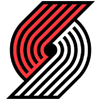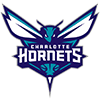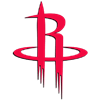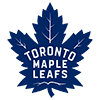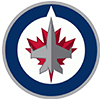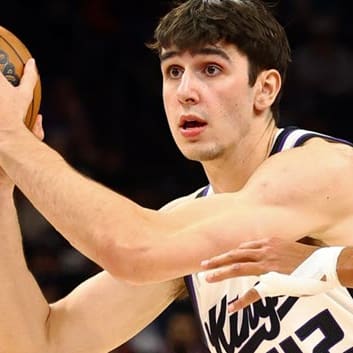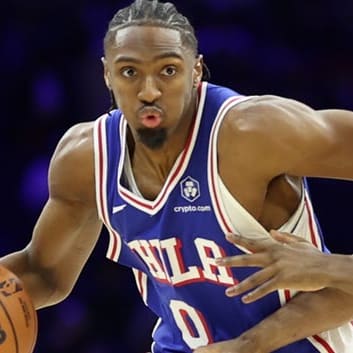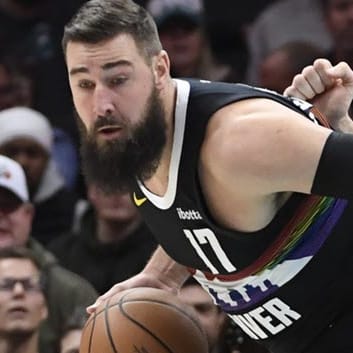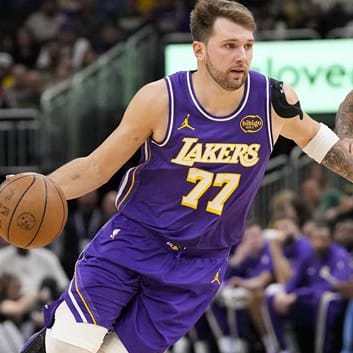Landing a handful of sleepers to supplement rosters is vital in the pursuit of championships in season-long formats. The list from season's past abounds with fantasy fixtures − Gerald Green in 2013-14; Chandler Parsons one year previous; heck, Kris Humphries in the unpredictably wild 2011-12 campaign delayed by the lockout − each of whom shored up vital weaknesses on squads across the fantasy hoops landscape. When owners find themselves lacking in a particular category, or worse, position, during a draft, the outlooks to follow should help alleviate a pressure-packed situation in a pinch.
Note: Positional eligibility depends on the medium, ESPN or Yahoo!. In addition, included in parentheses are the (ESPN/Yahoo!) ADPs and (ESPN/Yahoo!) Auction Values, respectively.
Point Guard
Trey Burke, PG, UTA (107/117) ($2/2) − Just one year removed from Burke settling in Utah via a draft-day trade with the Timberwolves, the Jazz selected Australian guard Dante Exum in the first round of the 2014 draft. Predictably, Burke's stock plunged with a direct threat to his standing as the starting point guard. Keep in mind, though, that Exum's rookie season will progress entirely during his final year as a teenager, when only the most special ballers make hay in the NBA. Meanwhile, Burke's expected backcourt mate, Alec Burks, will step into the two-guard spot vacated by Gordon Hayward's move to small forward, providing the 6-6 Exum with another landing spot in the rotation. With less pressure on Burke's gig, at least to tip off his second
Landing a handful of sleepers to supplement rosters is vital in the pursuit of championships in season-long formats. The list from season's past abounds with fantasy fixtures − Gerald Green in 2013-14; Chandler Parsons one year previous; heck, Kris Humphries in the unpredictably wild 2011-12 campaign delayed by the lockout − each of whom shored up vital weaknesses on squads across the fantasy hoops landscape. When owners find themselves lacking in a particular category, or worse, position, during a draft, the outlooks to follow should help alleviate a pressure-packed situation in a pinch.
Note: Positional eligibility depends on the medium, ESPN or Yahoo!. In addition, included in parentheses are the (ESPN/Yahoo!) ADPs and (ESPN/Yahoo!) Auction Values, respectively.
Point Guard
Trey Burke, PG, UTA (107/117) ($2/2) − Just one year removed from Burke settling in Utah via a draft-day trade with the Timberwolves, the Jazz selected Australian guard Dante Exum in the first round of the 2014 draft. Predictably, Burke's stock plunged with a direct threat to his standing as the starting point guard. Keep in mind, though, that Exum's rookie season will progress entirely during his final year as a teenager, when only the most special ballers make hay in the NBA. Meanwhile, Burke's expected backcourt mate, Alec Burks, will step into the two-guard spot vacated by Gordon Hayward's move to small forward, providing the 6-6 Exum with another landing spot in the rotation. With less pressure on Burke's gig, at least to tip off his second campaign, he should have little trouble sustaining his post-All-Star break run (34.3 minutes per game) from 2013-14, a stretch in which he averaged 13.2 points (on 40 percent shooting), 5.9 assists, 2.9 rebounds, and 1.6 three-pointers. With sparse defensive counting stats to speak of, his current standing in the eighth to 12th rounds of standard drafts makes the Michigan product well worth the risk.
Jeremy Lin, PG/SG, LAL (101/113) ($2/2) − Striking gold after the Linsanity craze consumed the basketball community during the 2011-12 lockout-shortened campaign, Lin arrived in Houston as the ultimate underdog story, with a three-year, backloaded $25 million contract in hand. He started every game at the point in his first year with the Rockets, but a spirited competition with Patrick Beverley in training camp in 2013 relegated Lin to a bench gig to tip off the 2013-14 season. Whenever injuries afflicted the backcourt duo of Beverley and James Harden, Lin was the logical choice to fill in, resulting in 33 starting nods scattered across the landscape. Overall, Lin's eventual line fell short of his initial standard in Houston, but his three-point prowess increased for a third consecutive campaign to 1.2 treys nightly on a crisp 36 percent. With the move to Lakerland in the offseason, he'll don the purple and gold behind Steve Nash in his age-41 season, but potential owners shouldn't fret. Despite greater health on his side, Nash is all but certain to succumb to the injury bug − he's taken the court for 65 of a possible 164 outings as a Laker − which leaves Lin primed to clean up the scraps. As a result, Lin's total output in Houston (13 points, 5.2 dimes, 2.8 rebounds, 1.3 steals, and 1.1 threes in 31 minutes per game) isn't out of the question.
Elfrid Payton, PG, ORL (100/97) ($2/2) − Selected 10th overall by the Sixers this summer, the curious move (hello, Michael Carter-Williams) was allayed following a draft-day trade to the Magic. The destination was slated to afford Payton an opening in the starting five and a young backcourt mate, Victor Oladipo, with whom he could become battle-tested. Or so everyone thought. Payton's five-game showing at the Orlando Pro Summer League included up-and-down performances, but on the back of three starts, he averaged a notable 9.2 points (on 59 percent shooting), 7.0 assists (versus 4.0 turnovers), 5.2 rebounds, and 1.4 steals in 26 minutes. The debut notwithstanding, coach Jacque Vaughn's preference for positionless basketball could place Payton in a reserve role to begin his rookie year, with Oladipo manning point guard and Evan Fournier playing off the ball. Oladipo's bout with a sprained MCL has thrown a wrench into those plans, though, which is allowing Payton significant run. The development throws added intrigue into the fire of training camp, but is the former Ragin' Cajun ready to handle a bit more scrutiny? A speculative dart in drafts could very well answer in the affirmative.
Shooting Guard
Bojan Bogdanovic, SG, BKN (140/-) ($0/-) − All but certain to emerge from October undrafted, outside of dynasty leagues, Bogdanovic has so far impressed coaches and teammates alike with his basketball IQ and fluidity on offense during camp. Speaking of offense, the former 2011 second-round pick completed the recent FIBA World Cup as the third-leading scorer, posting 21.2 points (on 50 percent shooting) and 2.2 three-pointers in 33.5 minutes per game for a frisky Croatian side. The six-game showing included a 27-point outburst against a capable NBA defender, France's Nicolas Batum, but Bogdanovic could endure the expected growing pains as he transitions from Fenerbahce of the Turkish Basketball League to Brooklyn. While Bogdanovic will be aided in his relocation by the presence of compatriot Mirza Teletovic, who can impart the trials and tribulations of the marathon that is the NBA slate, he's seemingly struck gold on another front. Bogdanovic's primary competition at shooting guard, Alan Anderson, has been plagued by an abdominal injury of late, supporting the notion that the newcomer will contribute immediately to the backcourt rotation. Prospective owners should monitor the situation closely in the event that Bogdanovic has in hand a starting job by Opening Night.
Alec Burks, SG/PG, UTA (122/141) ($0/1) − Burks will sidle into a guaranteed starting role for the first time in his career this fall, teaming up with Trey Burke to form a tantalizing yet raw backcourt duo. The presence of 2014 first-round pick Dante Exum shouldn't affect Burks' workload too much, but small forward Gordon Hayward, who got the nod at shooting guard in 73 of 77 appearances last year, could assume the position in certain lineups. Nonetheless, Burks proved to be a consistent scoring threat after the calendar flipped to February, achieving double-digit points in 28 of his final 29 contests. His per-36 numbers during that stretch reveal a jam-packed line − 19.2 points, 4.1 rebounds, 3.3 assists, 1.4 steals, and 0.9 three-pointers − while knocking down a robust 48.9 percent from the field. His touch from the free-throw line wavers at times, but with a career mark of 73.6 percent, an uptick in freebies (he attempted 4.8 in 28.1 minutes per outing in 2013-14) won't exactly sink a fantasy campaign. Aiding squads with across-the-board production, Burks is a prime threat to be the steal of steals during the upcoming draft season.
Kentavious Caldwell-Pope, SG, DET (140/142) ($0/1) − Yet another training camp battle exists in Detroit, where shooting guards Caldwell-Pope and free-agent pickup Jodie Meeks are jockeying for a position in the starting five. Absent from the first two exhibitions with back spasms, Meeks has given way to Caldwell-Pope, who has shocked all with 38 points (13-24 FG, 5-11 3Pt, 7-9 FT) in 58 combined minutes. Sure, it's the preseason, but offense is Meeks' forte, as opposed to Caldwell-Pope, owner of the ninth-worst true-shooting percentage (48.3) among players that logged at least 1,500 minutes last season. On the other hand, Caldwell-Pope was the backbone of the Pistons' attack in the Orlando Pro Summer League, where he supplied 24 points (on 40 percent from the floor), 7.4 rebounds, 2.4 three-pointers, 1.8 steals, and 1.6 assists in 30 minutes per game. The previous line is skewed due to the subpar opposition, but scoring may not be the worry that accompanied his initial NBA forays last season. Thus, no matter who emerges victorious, Caldwell-Pope appears poised to correct the woes of his rookie campaign, provided his sprained left knee doesn't require a lengthy absence.
Andre Roberson, SG, OKC (140/135) ($0/-) − Embroiled in a competition with Jeremy Lamb for the starting spot at two-guard, Roberson has a number of check marks on his side of the ledger, namely on defense, which the Thunder preach from management to towel boy. When taking a gander at Roberson's Orlando Pro Summer League output from July, three numbers in particular entice: 8.3 boards, 2.3 steals, and 0.8 blocks in 29 minutes per contest. The former is a product of the offensive glass, where he ranked first in rebounding percentage among the league's guards that played at least 400 minutes last season. That fact aside, playing alongside the similarly lanky Kevin Durant and Russell Westbrook will leave the 6-7 Roberson unhinged to trouble opposing two guards and rack up defensive counting stats, if his summer performance indeed translates to the regular season. Meanwhile, potential owners may be irked by his lack of offensive acumen, but a dogged retooling of his shooting stroke has already reaped benefits. After accruing a measly two treys in limited work last year, he knocked down 2-of-6 in Orlando, which he's followed up with one success (in one attempt) across two preseason games. On Sunday, Durant was diagnosed with a fractured right foot, which should place Roberson in a significant, if not starting, role during the 10-week recovery timetable.
Small Forward
Draymond Green, SF, GS (117/140) ($0/1) − The Warriors' lineup is one composed of interchangeable parts, and coming off a season in which three starters − Andre Iguodala, David Lee, and Andrew Bogut − tallied between 13 and 19 DNPs, the top reserves are assured time in the starting lineup at some juncture. When Lee and Bogut dealt with various injuries at the tail end of the 2013-14 campaign, Green filled in at the four, recording 27-plus minutes in 15 of 21 outings after March 18 (including the postseason). During that span, Green averaged 9.2 points (on 46 percent shooting), 7.1 rebounds, 2.6 assists, 1.6 steals, 1.4 blocks, and one three-pointer in 30 minutes. In an effort to develop into more of a stretch four, he spent much of the offseason working on his jumper, which has been evident through two preseason contests, with half of his 16 field goal attempts coming from beyond the arc. Even if he experiences just a modest uptick in his 22 minutes per game from a season ago, three-pointers and defensive offerings should be reliable aspects of his game.
Solomon Hill, SF, IND (140/141) ($0/1) − The viewing public is well aware of Hill's standing in the organization, but the earnest praise bestowed upon him by the likes of executive Larry Bird and coach Frank Vogel presents itself as trivial until the forward executes on the court. Although Hill will be afforded more chances as a sophomore following Paul George's gruesome broken leg sustained during a warmup event in advance of the FIBA World Cup, offseason addition C.J. Miles presents a knoll to climb in pursuit of the top lineup. Neither Hill nor Miles has distinguished themselves after two exhibition outings entering Sunday − Hill has totaled eight points, six rebounds, and three assists in 47 minutes, while misfiring more often than not (2-9 FG, 0-2 FT) − which may force Vogel to ride the known entity, Miles, until Hill is prepared for prime time. However, playing time fails to equate to production only in the rarest of occasions (see, Aaron Gray), meaning Hill should hold utility in at least deep formats as the season approaches.
K.J. McDaniels, SF, PHI (100/142) ($0/1) − For lack of a better term, McDaniels is a curious case. Drafted 32nd in the 2014 draft, the 6-6, 200 pound guard possesses the defensive mentality desired by coach Brett Brown, a Gregg Popovich protege, and with both spots on the wing unsettled early in training camp, McDaniels has a grand opportunity to stake a claim to sufficient minutes to launch his NBA career. While McDaniels' summer league experience in Orlando was mostly nondescript − 10 points, 2.5 rebounds, and one block in 17 minutes per game, with five total treys across four outings − he's brandished a stopper's mindset in the preseason, recording four swipes and six swats in three contests (upholding an ACC-leading 100 blocks at Clemson last year). However, after drilling just 31 percent from the three-point arc in three collegiate campaigns, little is expected of him as a scorer off the bat, meaning any fare yielded on that end of the court is gravy.
Power Forward
Markieff Morris, PF/C, PHO (92/128) ($2/2) − As the preseason opens, the Suns have experienced a minor tweak to the starting five with the departure of power forward Channing Frye via free agency. Management hasn't exactly left coach Jeff Hornacek dry in Frye's stead, though, as Morris has been groomed to embrace an inflated role. Even though he came off the bench in all 81 appearances in 2013-14, Morris' status as a reserve didn't stop him from finding a groove after the All-Star break, when he upped his usage to 29 minutes per outing. The corresponding per-36 output from that stretch was tremendous − 20 points, 7.9 boards, 2.5 assists, 1.1 steals, and 0.8 blocks − and his field goal percentage in fact swelled to 52 from 46 percent in the first half. If he assumes a shred of Frye's responsibilities as a stretch four, which accommodated 5.3 attempts nightly from three-point range last year, Morris, a career 33 percent shooter from deep, could develop into a rare across-the-board contributor from an uncommon position.
Jared Sullinger, PF/C, BOS (100/128) ($2/1) − Sullinger's rookie campaign in 2012-13 was abbreviated due to back surgery, but he sidestepped injury last season en route to the seventh-most double-doubles among players that logged less than 30 minutes per contest. Boasting averages of 13.3 points and 8.1 rebounds in 28 minutes, he otherwise tallied nonexistent lines and knocked down an uninspiring 43 percent from the field, mostly on the back of an increased emphasis from beyond the arc, where he prevailed a shoddy 27 percent of the time. During the offseason, though, he clearly attempted to hone in his shot, and the results have been evident through four preseason games, as he's drilled 7-of-12 three-pointers. In addition, coach Brad Stevens has so far committed to a starting frontcourt of Sullinger and Kelly Olynyk, and with consistency on his side, the Ohio State product may transform into a strong three-category performer.
Center
Jordan Hill, C/PF, LAL (108/116) ($2/1) − With the hefty salaries of Kobe Bryant, Jeremy Lin, and Steve Nash weighing down the Lakers' cap figure, general manager Mitch Kupchak has patched together a roster of cost-effective options. Therefore, each slot in the starting lineup is set in stone outside of point guard, which is of course contingent upon Nash's health. When exploring the pecking order at the five, Hill represents the preferred pick due to his holdover status and lack of viable alternatives, which includes the likes of Ed Davis and Robert Sacre. Throughout Hill's first four years in the league, starts were few and far between, but beleaguered coach Mike D'Antoni was forced to hand the big man 32 nods on last season's injury-laden group. Hill particularly thrived in nine outings as the No. 1 center, averaging 16.8 points (on 52 percent from the floor), 10.4 boards, 1.7 blocks, 1.6 assists, and 1.0 steals in 29 minutes. While the line is telling, the sample size may cause owners to balk at his services, a development that should be pounced upon if it occurs in drafts.
Enes Kanter, PF/C, UTA (118/119) ($0/1) − During the summer of 2013, the departure of Al Jefferson and Paul Millsap in free agency was intended to be a boon to the prospects of Kanter and Derrick Favors, who tipped off last season as the Jazz's starting frontcourt. Instead, Kanter meandered between the top lineup and reserve unit as the year continued, yet still rang in with a career-high 12.3 points and 7.5 rebounds in 26.7 minutes per game. New coach Quin Snyder has seemingly committed to Kanter as his starting four for the 2014-15 campaign, which should help the Turkish big man boost his double-double total (24 in 80 games) from the previous campaign. Unfortunately, Kanter's nightly contributions are negligible elsewhere, meaning he must keep a tight grip on a starting gig or imperil his fantasy utility.
Kelly Olynyk, C, BOS (119/139) ($1/1) − In advance of last season's opener, Celtics' coach Brad Stevens imagined a world in which Olynyk led the team in minutes. Instead, Olynyk finished his rookie year ranked ninth on the squad in playing time, as he endured the typical rookie blues. His uneven run aside, Olynyk supplied double-digit scoring in all but one of the team's final eight games, while sniping multiple treys on four occasions, on his way to 16.6 points (on 55 percent shooting), 7.3 rebounds, 2.3 assists, and 1.1 threes in 26 minutes per outing. Stevens has deployed Olynyk and Jared Sullinger as the starting big men during the current exhibition season, and Olynyk, the Canadian, has resumed his reign of terror from outside, punching in 7-of-11 three-pointers. It remains to be seen if Olynyk can humor owners with sustainable yields in other categories, but scoring, particularly from range, is his principal speciality in the early stages of his career.
If you, the reader, would like another baller covered, don't hesitate to send along a request in the comments. We'll do our best to respond in a prompt manner.















